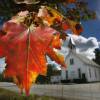The Northeast experienced its fourth warmest autumn on record this year, according to a new report from the University of Massachusetts Climate System Research Center. Since 1895 — when said record began — autumn temperatures have been rising by about 0.2 degrees fahrenheit every decade. And it was a wet one, as well, with the area experiencing its twelfth wettest fall. The climate crisis has a direct impact on the foliage and snowfall (or, lack thereof) that many associate with New England in late fall/early winter. But the warmer temperatures also have ramifications for the region's tourism industry.
Tim Sink, president of the Greater Concord Chamber of Commerce, considers a warmer autumn somewhat of a blessing. This year, despite the fact that warmer temperatures correlated with a delay in prime foliage, he noted that the foliage season lasted longer and brought continued traffic to the area from leaf peepers.
While the warmth might be welcome for the tourist who wants to see leaves ablaze, it is less ideal for those who love or rely on snow. Sink noted that the Northeast has yet to experience any significant snowfall, a tense situation considering that many ski resorts open to the public this month. Even though the leaf economy was strong this fall, Sink warned that a poor ski season could offset any earlier autumnal gains.
Along with warmer weather comes wetter weather, too. According to the same UMass report, 16.5 inches of rain fell across Massachusetts this autumn, more than any other state in the northeast.
Amy Cotter, the director of climate strategies at the Lincoln Institute of Land Policy in Cambridge, suggests natural solutions to the damaging effects of climate change throughout the region. In her view, it all comes back to trees, who's crisis mitigation skills are unmatched.
For example, increased rainfall means greater risk of floods, but Cotter said planting more plants and trees can help manage water flow by assisting with ground absorption.
Planted vegetation pulls double duty by dealing with heat, too. According to the Environmental Protection Agency, shaded surfaces can be 20-45 degrees cooler than unshaded ones. And vegetation has an impact on air temperature via the process of evapotranspiration, by which evaporation from the land surface plus transpiration from plants warms or cools the environment.
“This is an opportunity to embrace nature,” Cotter said. “Nature is amazing at helping us tackle heat and water. We can do that in a way that makes life more enjoyable for people in our cities; in ways that can protect against heat and drought.”








